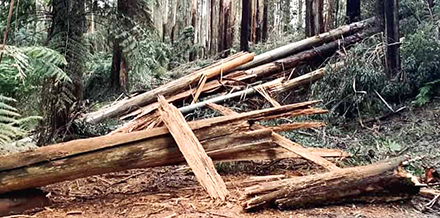Now that Victoria’s native logging has been shut down the consequences will be felt even more acutely, though many sawmills and harvesting operations were shut down last year. This is the end of an era. Source: Timberbiz
Timber Towns Victoria has acknowledged the loss of regenerative native mixed species forest harvesting which was actively managed. In Australia, forested landscapes are likely to have been actively and adaptively managed by Aboriginal and Torres Strait Islander peoples for more than 60,000 years.
These sustainably regenerative managed forests operated under strict Australian Standards and stringent auditing. Under ecologically sustainable forest management, active management practices are required to maintain resilient and healthy forests that can withstand the impacts of threats including bushfires, invasive species and climate change.
“Unfortunately, the industry has long been misunderstood by the State Government and the broader community and has ultimately been brought to its knees,” Timber Towns Victoria President and Mayor of the Glenelg Shire, Cr Karen Stephens said.
“The loss of active forest management practices will ultimately mean the loss of generational knowledge, loss of carbon capture in regrowth forest areas after harvesting, and the loss of the flow on benefits to communities and the environment.”
An economic impact report commissioned by the Wellington and East Gippsland Shires in 2021 estimated that the ban on native timber harvesting would result in approximately 1,110 job losses and output to drop by $308 million.
“In contrast to the ban on native timber harvesting, there are a multitude of benefits from the sustainable management of our forests and as the peak local government body for Victoria on forest policy, we wish to discuss these with the State Government and work towards a positive solution for Victoria and our communities.
“We call on the government to advise Timber Towns Victoria and the community, what strategies do you have in place for the future sustainable management of forest health, bushfire risks, conservation of biodiversity, and maximising carbon outcomes.” Cr Stephens said.
What will happen to the native forest is a cause for speculation.
According to The Weekly Times an Environmental Assessment Council report recommended that 300,000ha of state forest should be brought within a large protect area such as a national park that could stretch from the Yarra Ranges across Kingake, Lake Eildon, Baw Baw, Bunyip, Cathedral Range and the Moondarra state parks. It would block hunters, firewood collectors, campers, horse and trail bike riders and others from the area.
Whether environmental groups are satisfied now is unlikely as it was reported by ABC Rural that Environmental Justice Australia special counsel Danya Jacobs was concerned that native forest logging could continue rebranded as bushfire management or salvage operations and she was calling on the government to close what she terms loopholes.






